- Home
- News
- Why Loading Docks Need Vehicle Restraint Systems
Intro to Vehicle Restraints: What are Vehicle Restraint Systems and Why are they Necessary?
In 1978, the Occupational Safety and Health Administration (OSHA) mandated the use of wheel chocks to help prevent trucks from leaving the dock during loading and unloading. The new standard was a small step toward a safer loading dock, helping address rising concerns about trailer separation accidents related to wheel chocks.
However, it was quickly realized that simply chocking tires (manually wedging materials against or between a trailer’s wheels) had limitations, proving to be unreliable in helping prevent trailer movement. This was due to:
- Inadequate restraining force, especially if the wrong sized chock is used relative to a tire.
- Reliance on human accuracy for proper placement.
- Lack of reliability on uneven, wet, snowy or icy surfaces.
- Reduced effectiveness with tire types and pressure levels.
- Material options susceptible to damage from weather and harsh environments (wood, rubber, metal).
- Threat of being misplaced or stolen from the drive approach.
Rite-Hite understood that wheel chocks were inadequate, and products, equipment and people were still at risk. The company spent years developing a dependable solution that would win when challenged. In 1980, Rite-Hite invented the vehicle restraint industry with the introduction of the Original Dok-Lok® Rotating Hook Restraint.
With light communication as standard, the Dok-Lok mechanical solution was mounted to the facility’s wall, hooking up and around a trailer’s interstate commerce commission (ICC) bar. Within one year, OSHA amended their original standard to include “mechanical means,” formally recognizing Dok-Lok as a preferred alternative to wheel chocks.
For over 45 years, facilities have adopted various vehicle restraint policies and systems based on their loading dock applications to help prevent trailer separation accidents.
What is trailer separation and what causes it?
Trailer separation accidents occur when a trailer moves away — either intentionally or unintentionally — from the loading dock. This creates a dangerous gap between the trailer bed and warehouse floor that people, products and equipment can fall into.
The National Institute of Standards and Technology reports that 7% of all forklift accidents occur when one runs off the edge of dock. So it’s critical that facilities understand the risk of trailer separation if they choose simple wheel chocks without light communication systems.
There are five main trailer separation accidents: trailer creep, early departure, landing gear collapse, trailer upending and trailer pop-up.
Trailer creep (dock walk)
Trailer creep happens when an unrestrained trailer gradually moves away from the loading dock due to momentum created by a forklift repeatedly traveling into and out of the trailer. Eventually, the leveler lip or dock board loses contact with the bed of the trailer, forming a gap for a forklift of material handler to fall into. Air ride trailers, which account for over 90% of trailers on the road, compound the problem.
Simple wheel chocks fail to properly address trailer creep — they can slip, get misplaced, or be pushed or pulled out of the way.
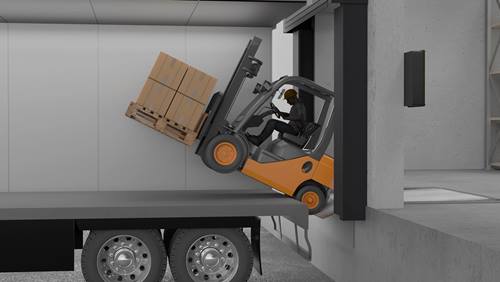
Early departure (or aggressive pullout)
Early departure happens when the truck driver prematurely pulls away from the loading dock during loading operations. This puts a forklift at risk of either falling off the edge of dock or being stranded in a trailer. Premature departure is often due to lack of proper communication between truck drivers and dock workers.
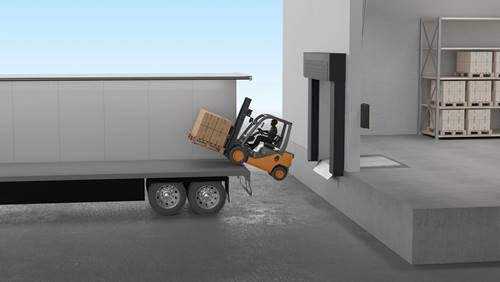
Landing gear failure (or landing gear collapse)
Weak or corroded landing gears can give way under the impact of loading/unloading operations. With landing gear failure, the nose of a spotted (dropped) trailer collapses to the ground. This loading dock accident forces the rear of the trailer, including the RIG, to rise vertically and away from the loading dock. If the dropped trailer is not secured by a trailer stand, landing gear collapse can cause it to tip over and create a cascading domino effect as adjacent trailers fall into each other one by one.
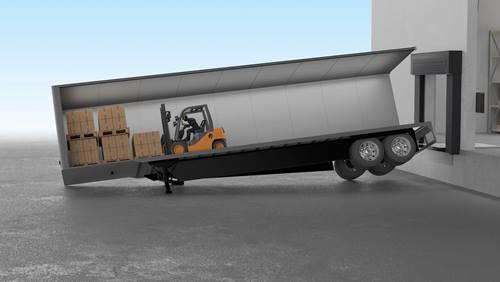
Trailer upending
Trailer upending often occurs with pup trailers. When the first heavy load is placed in the nose of the spotted trailer, the rear of the trailer can rise up and away from the dock.
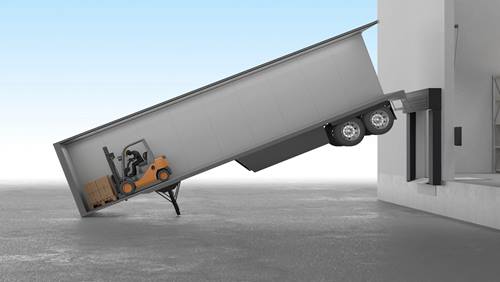
Trailer pop-up
Trailer pop-up can happen when a heavy load is placed on the rear of an empty (or nearly empty) trailer, forcing the trailer’s rear into the ground, popping its nose up in the air.
Each trailer separation accident that can occur during loading operations is attributed to specific factors during loading operations — including repeated forklift impacts, aggressive pullouts, landing gear collapse and weight distribution issues — cause trailer separation accidents. This underscores the need for improved safety measures beyond traditional simple wheel chocks, such as enhanced vehicle restraint systems.
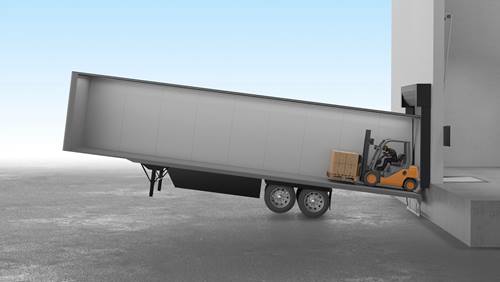
What is a vehicle restraint system?
Also referred to as “trailer restraints” or “truck restraints,” vehicle restraints are mechanical devices that keep trailers from separating from the loading dock during loading/unloading operations. Depending on trailer type and application, these devices either restrain a trailer’s rear impact guard (RIG) or are placed between the rear trailer tires. Vehicle restraints exceed OSHA requirements while helping improve safety, productivity and security at the loading dock.
What is a dock lock?
“Dock lock” is another general term for a vehicle restraint that’s derived from Rite-Hite's Dok-Lok. Initially designed for restraining the ICC or RIG bar, dock locks service a wide variety of trailers including standard over-the-road, obstructed, liftgate, parcel, specialty and more.
Often imitated but never duplicated, “Dok-Lok” has become the industry term commonly used by shippers, distribution centers and warehouses since 1980.
Types of vehicle restraint systems at the loading dock
Four types of vehicle restraints are designed for the widest variety of trailers and applications: Rotating Hook Restraints, Stabilizing Trailer Restraints, Vertical Barrier Restraints and Wheel-Based Restraints.
Rotating Hook Restraints
Rotating Hook Restraints feature an exclusive design that gives facilities the industry's widest wrap around the trailer RIG. This helps reduce both horizontal and vertical movement during loading/unloading operations. Rotating Hooks can be enhanced with Shadow Hook® technology to safely capture intermodal containers and obstructed RIGs.
Our models: SHR-5100 | RHR-1100 | GRH-100
Stabilizing Trailer Restraints
Stabilizing Trailer Restraints utilize hydraulic cylinders to reduce variability with horizonal and vertical trailer movement during loading/unloading. Supporting wider and heavier loads, including automated guided vehicles (AGVs), stabilizing trailer restraints provide the industry's smoothest transition from warehouse floor to trailer bed.
Our models: STR-4200
Vertical Barrier Restraints
Vertical Barrier Restraints feature a 4.25″ high exclusive barrier with reverse taper design that provides solid, dependable upward pressure to a RIG — ideal for live loading.
Our models: VBR-350 | VBR-310 | VBR-100 | VBR-600
Wheel-Based Restraints
Wheel-Based Restraints secure the rear wheels of the trailer, rather than the rear impact guard. These restraints are necessary for liftgates, parcel/delivery trucks or broken/missing RIGs.
Our models: GWL-2300 | MWL-1300 | GWC-1000
Regardless of vehicle restraint type, installation should always be handled by certified technicians who can also provide repair and maintenance services at the loading dock.
Do facilities really need vehicle restraints?
The loading dock is a dangerous place. OSHA reports that 25% of all reported industrial accidents take place at the loading dock.
Recognizing the risks, OSHA created standard (29 CFR 1910.178(k)(1) and (m)(7), which require usage of wheel chocks or mechanical means at the loading dock.
For these reasons and many others, facilities do need vehicle restraints at the loading dock. They’re an effective way to help protect product, equipment — and most importantly people.
Vehicle restraints are crucial for any facility with loading operations because they:
Contact Rite-Hite today
If you are a facility manager, architect, general contractor or otherwise tasked with selecting a vehicle restraint for a facility’s loading docks, get in touch to learn more about making the appropriate equipment selections for your application.
Discover the Right Dok-Lok for You